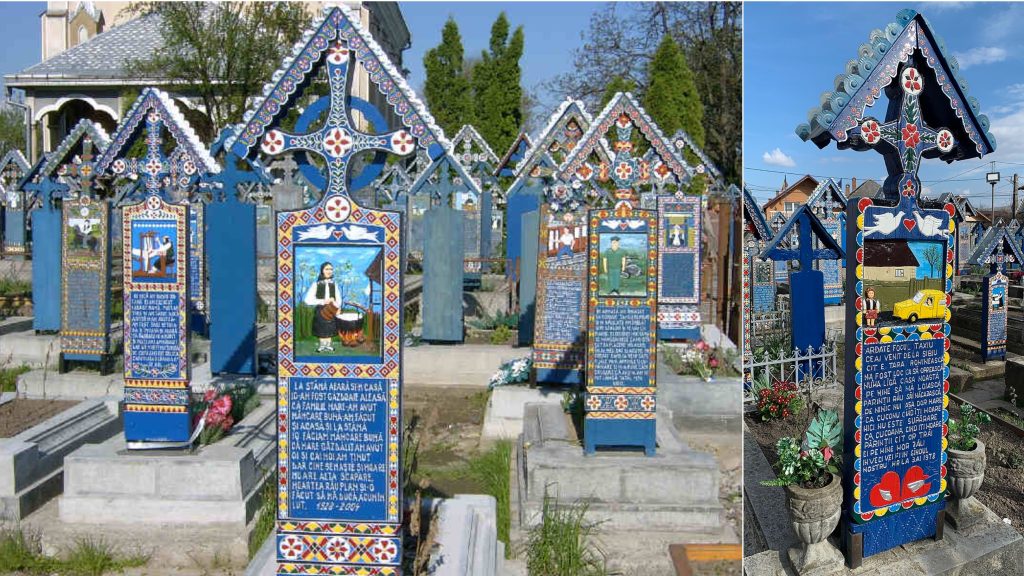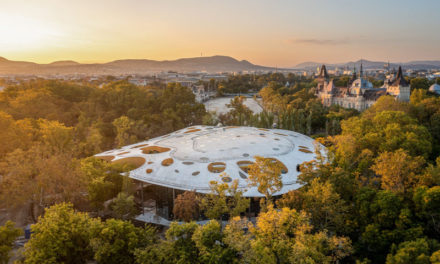There is a cemetery, not so far away, where they are not afraid to remember the dead with funny, surprising, sometimes tasteless epitaphs.
Szaplonca (Romanian: Săpânța) is a small village on the left bank of the Tisza in Máramaros County, close to Máramaros Island. The local cemetery is completely different from what we are used to here: nearly eight hundred headstones, painted in the typical Szaplona blue, say goodbye to the deceased with cheerful rhymes and the language of naive poetry.
The history of special head trees
The history of the fun cemetery in Szaplona began in 1935, when the first distinctive head trees were placed on the graves. We owe these to the master engraver Stan Ioan Pătraş, who carved a scene taken from the life of the deceased on the oak crosses painted with blue oil paint and a few lines of funny and cheerful verses that do not care much about spelling and punctuation, which can actually be understood as fictitious messages from the other world. There are times when people write the lines that will go to the grave for themselves in advance.
I rest here
My name is Braic Ileana
I had five bachelor children
God bless you all
I forgive you Griga
Although you cut me with your knife
When you stabbed me drunk
But you buried me decently
Here at the foot of the great church
You will also convert to me.
***
I rest here
My name is Pop George Ocuta
While I was living my world
I roasted many, many pigs
I also ate a lot of meat
That could have been my loss.
A few more years would have been nice
A little old age
But death did not leave me
He ordered underground.
I said goodbye to my life
At the age of 43.
Until Pătraş's death in 1977, about 800 such grave markers were added to the cemetery, after which his student Dumitru Pop-Tincu continued the work.
The head trees sometimes show the personality and occupation of the deceased, sometimes they discuss the circumstances of his life or death, without much subtlety. Some of them show, for example, a road accident in the form of a drawing, or the poem says that the person died due to being hit by a train.
I paid for everything
Where death has reached
Somewhere on Mount Mires
The wagon wheel came to me.
I was engrossed in the game
I got hit by a train.
My mother is waiting for me to come home
His grief does not go away.
***
I rest here
My name is Stan George
Poor life, the end has come
He became nothing like ice
I got it on Elijah's day
The lightning was stronger than me
My father was angry
And my mother couldn't rest either
It made me cry forever.
I left young
I was 19.
By reading the inscriptions, we can see the life, composition and customs of the entire village. There are those who have been immortalized with their favorite horse, tractor or even their drink bottle. Women are most often seen cooking, washing or weaving.
The poems and pictures depict the life of the deceased, condensed into a single moment, like peasant photos: the way he wanted to see himself and be seen, indicating that he met the community's standards.
Under this heavy cross
My poor mother-in-law is lying down.
If he had lived three more days
I would lie here, he would read.
You who left here
Try not to wake me up
Because when he comes home…
I rest here
The verses (in Romanian) could appear on the graves because, after the signing of the Trianon Peace Treaty, they wanted to ensure that the population spoke only Romanian. The series of actions prohibiting the use of the mother tongue of minorities culminated in the new public administration law that came into force in 1936, which already prescribed a whole series of strict and retaliatory measures for the use of the mother tongue. In order to "strengthen" the Romanian language, Grigore Rițiu, a Greek Catholic priest and also a teacher of Romanian and Latin, asked the master to thicken the legs of the crosses and write a longer Romanian epitaph on them.
The curse of popularity - stolen heads
The cemetery became so popular that there were reports of head trees being stolen.
The sight attracts thousands of visitors, who often walk around smiling at the inscriptions, giving this cemetery a special atmosphere. Not far from here is the former master's house, where his apprentice currently makes the roughly ten head trees a year. If it's open, you can peek into one of the rooms furnished as an exhibition hall.
Special, but not a World Heritage Site
It is mentioned in several places that the cemetery was added to the UNESCO World Heritage List, but this is not true (fortunately - the editor) . The reason for the misunderstanding may be that the wooden churches of Máramaros are on the world heritage list. There is a church with a 78-meter-high wooden tower in the Szaplonca cemetery, but the name of the Szaplonca settlement and its church is not included in the list of Máramaros wooden churches.












